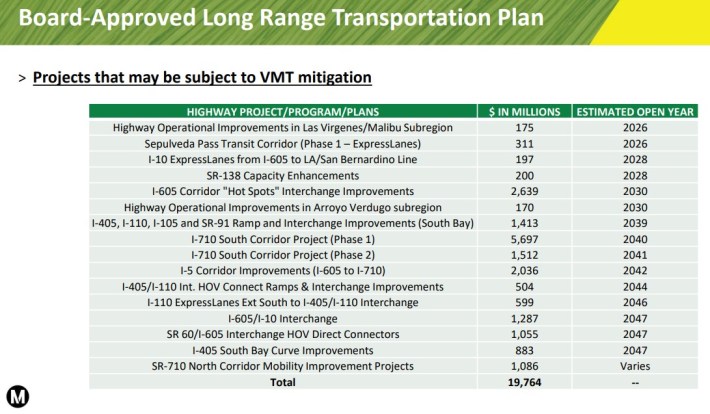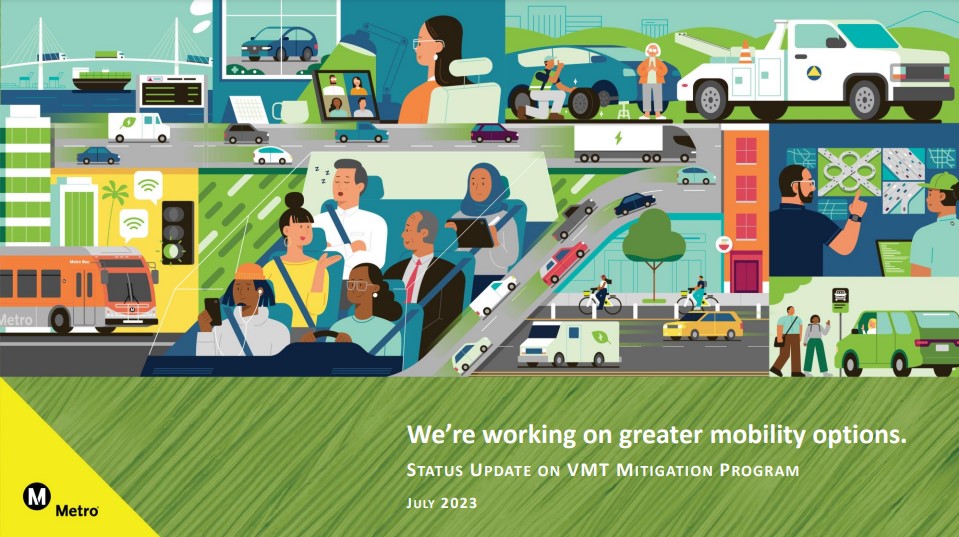Today's scintillating topic is VMT mitigation. VMT Mitigation! VMT stands for Vehicle Miles Traveled. Mitigation means making bad things less bad.
VMT mitigation is a wonky, jargon-filled subject. It is potentially very impactful, but difficult to explain. Streetsblog is breaking this VMT mitigation explainer into two posts. Today's post is focused on the past - what is VMT mitigation, how did it get here, and where grandfathering means projects not mitigating. Part 2 will focus on how VMT mitigation is likely to shape future projects.
The VMT mitigation story gets going back in 2013 when the state legislature passed S.B. 743, which shifted the way California measures environmental impacts from LOS (Level of Service) to VMT (Vehicle Miles Traveled). California environmental law (CEQA - the California Environmental Quality Act) requires project planners (people who build freeways, rail, housing, etc.) to study a project's environmental impacts.
For decades, LOS was the standard way that project studies quantified the environmental impact of proposed transportation changes. But what LOS measures is only the delay a project might cause to drivers. LOS basically says that anything that slows drivers down - such as converting car lanes to space for transit, bicycling, or walking - is bad for the environment.
Some people noticed that this topsy-turvy way of measuring environmental impacts was encouraging unwanted outcomes: big wide roads that discourage environmentally friendly travel and increase greenhouse gas emissions. So legislators passed S.B. 743, which forced state planners to find an alternative to LOS.
S.B. 743 triggered a seven-year state rule-making process that ended when the state Office of Planning and Research decided to require projects to measure VMT instead of LOS. Now when projects are studied under CEQA, those that result in more driving show up as being harmful to the environment. The bigger the increase in driving, the more harmful.
In July 2020, Caltrans announced that all California transportation projects that increase driving (VMT) require mitigation. Effectively, Caltrans told Metro (and everyone else): if you widen freeways/ramps/roadways, then you have to mitigate the increase in driving that the project causes - essentially you also have to include things that get people out of their cars as part of your project.
Caltrans VMT mitigation requirement applies to all projects starting the CEQA environmental clearance process.
But there were lots of projects already in the pipeline. Since the new requirement took effect, Metro has started unmitigated construction on VMT-inducing widening of the 5, 57/60, 71, and 405 Freeways (plus other ramp and road widening projects). Those freeway expansion projects were approved prior to 2020, so they were grandfathered in.
And that's not all. In L.A. County, Metro and Caltrans still have around a dozen future L.A. County freeway expansions that completed their environmental approval process before July 2020.
Due to freeway-permissive approval processes, few freeway projects are subject to the same full public environmental clearance that Metro applies to bus, rail, and bike infrastructure. Instead, Caltrans and Metro approve freeway widenings with abbreviated environmental studies, mostly via Categorical Exemption (CE), Notice of Exemption (NOE), Finding of No Significant Impact (FONSI), or Negative Declaration (ND). Yes, agencies have four different ways to declare that widening a freeway would have no harmful impacts on the environment.
Recently Metro and Caltrans have avoided full environmental studies by exploiting a loophole; they often take advantage of a state regulation regarding what are called "auxiliary" lanes: freeway lanes that extend from one onramp to the next off-ramp.
California exempts projects from having to study VMT impacts if they "would not likely lead to a substantial or measurable increase in vehicle travel," specifically including "addition of an auxiliary lane of less than one mile in length designed to improve roadway safety." Metro and Caltrans District 7 have been busy approving dozens of under-one-mile-long aux lane projects, often as part of bigger projects that widen several miles of freeway.
Without ever completing a full CEQA Environmental Impact Report (EIR) process, Metro and Caltrans have recently approved demolitions of homes (for example, the 91 Freeway widening from Shoemaker Avenue to 605/Alondra Boulevard was cleared via FONSI in 2019; that project later backed off the approved demolitions, instead taking only slivers of property) and new general purpose non-auxiliary lanes (for example, 405 Freeway widening from Artesia Boulevard to the 105 was also cleared via FONSI in 2019; that project adds several auxiliary lane segments and one general purpose lane, and was approved under the auxiliary lane exemption.)
Below is a list of already-approved future Metro/Caltrans freeway expansion projects that have been grandfathered in, so will likely not be required to mitigate VMT increases:
- 60 Freeway 7th Avenue ramp widening - 2020 CE
- 71 Freeway widening (north of current under construction phase) - 2002 FONSI
- 91 Freeway widening from Shoemaker to 605/Alondra - 2019 FONSI
- 405 Freeway widening from Artesia to the 105 - June 2020 NOE
- 605 Freeway Beverly Boulevard ramp/road widening - 2019 ND
- 605 Freeway South Street ramp widening - 2019 NOE
- 605 Freeway Valley Boulevard ramp/road widening - May 2020 ND
Metro and Caltrans highway builders knew the VMT requirement was in the works, and they were busy clearing freeway expansions right up until the July 2020 announcement. The agencies cleared three expansions in 2019 and two more in early 2020 just prior to the VMT mitigation requirement starting in July.
It is possible that the two agencies' rush to approve the 605 Freeway Corridor Improvement Project (605CIP) Environmental Impact Report (EIR) by late 2020 may have been an attempt to skirt impending VMT mitigation requirements. That push backfired, as the project's mass residential demolitions triggered a community backlash which forced Metro to scale it back so as not to displace housing.
Since the VMT mitigation requirement took effect, Metro and Caltrans have continued to approve new freeway widening projects with no VMT mitigation, including:
- 91 Freeway widening from Atlantic Avenue to Cherry Avenue - May 2021 FONSI
- 91 Freeway widening from Central Avenue to Acacia Court - March 2021 FONSI
After the 2020 VMT mitigation requirement kicked in, FONSI documents assert the falsehood that, despite adding new freeway lane mileage, these projects would not increase driving. For example, the 91 Atlantic to Cherry FONSI asserts that "the project is not increasing capacity" and "the primary purpose of the addition of an auxiliary lane is to improve safety, traffic operations, and not to increase capacity."
That is an oft-repeated, gaslighting lie. Metro frequently asserts that its freeway expansion projects - projects that definitely add more lanes, and definitely expand freeway capacity - are not intended to add capacity, but are just for "safety," "gap closures," "correcting bottlenecks," or vague "operational improvements." All those are recent Metro euphemisms for widened freeways.
Today Metro and Caltrans are still pushing freeway expansion projects through opaque, cursory "no significant impact" approval processes. For example, their 405 Freeway widening from Wilmington Avenue to Main Street is entering its environmental clearance phase in Summer 2023 (per current Metro project page). That project would add five new auxiliary lane segments totaling about 4.5 new lane miles. Will the agencies ultimately find those new 405 Freeway lanes to be "categorically exempt" or have "no significant impact"? Or will the agencies get real and admit that adding miles of new freeway lanes would indeed trigger more driving?
The good news is that Metro actually does anticipate possibly having to do some kind of VMT mitigation in the not too distant future. At the Metro board meeting last month [staff report], agency staff shared a list of sixteen upcoming Metro/Caltrans freeway expansion projects (some of which include multiple project components) that "may be subject to VMT mitigation."

Projects that Metro anticipates "may" require VMT mitigation include Metro and Caltrans' planned future widening of the 5, 10, 60, 91, 105, 110, 138, 405, 605, and 710 Freeways.
What might that future VMT mitigation look like? Stay tuned for part 2, posting at SBLA next week.







